Bioactive Wound Dressing Market Size and Share
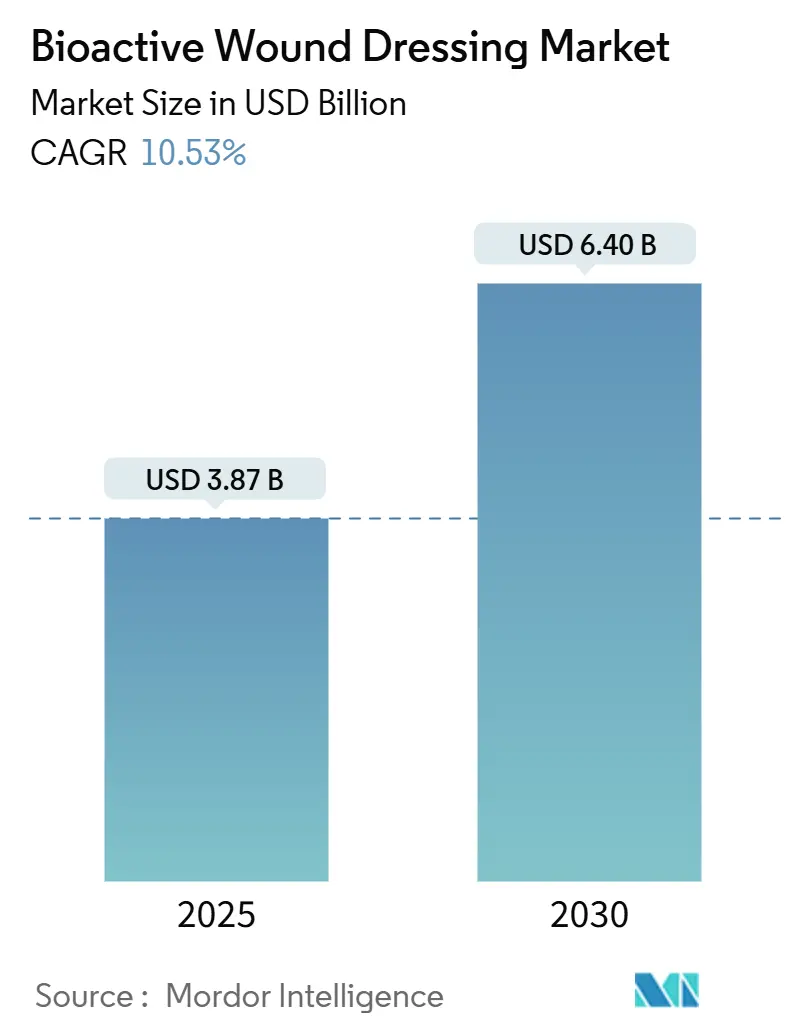
Bioactive Wound Dressing Market Analysis by Mordor Intelligence
The bioactive wound dressing market stood at USD 3.87 billion in 2025 and is forecast to reach USD 6.40 billion by 2030, reflecting a 10.53% CAGR. Rapid growth stems from a confluence of aging populations, rising diabetes prevalence, and continuous breakthroughs in biomaterial science that are broadening clinical applications and enhancing healing outcomes. Demand intensifies as traditional hydrocolloid and alginate dressings give way to intelligent sensor-integrated platforms capable of real-time biomarker monitoring, while government payers increasingly reimburse premium solutions that shorten healing time and lower complication rates. Defense and trauma medicine open additional niches through fish-skin grafts, and wider reimbursement in OECD markets reduces cost friction for hospitals adopting advanced therapies. Smart bio-electronic dressings, although a smaller revenue slice today, record the fastest adoption trajectory as Internet-of-Things (IoT) functionality and predictive analytics move from pilot studies into commercial practice.
Key Report Takeaways
- By product category, skin substitutes led with 43.16% revenue share of the bioactive wound dressing market in 2024; smart bio-electronic dressings are projected to expand at an 11.12% CAGR through 2030.
- By application, surgical and traumatic wounds held 46.48% of bioactive wound dressing market share in 2024, while diabetic foot ulcers are forecast to grow at 11.36% CAGR to 2030.
- By end user, inpatient settings held a 79.39% share of the bioactive wound dressing market in 2024; outpatient and ambulatory centers, with an 11.62% CAGR through 2030, represent the fastest-growing setting.
- By geography, North America maintained 42.67% revenue share of the bioactive wound dressing market in 2024, whereas Asia-Pacific is advancing at an 11.84% CAGR through 2030.
Global Bioactive Wound Dressing Market Trends and Insights
Drivers Impact Analysis
| Driver | (~) % Impact on CAGR Forecast | Geographic Relevance | Impact Timeline |
|---|---|---|---|
| Growing burden of chronic wounds & diabetes | +2.8% | Global, strongest in North America & Asia-Pacific | Long term (≥ 4 years) |
| Rapid innovation in biomaterial science | +2.1% | Global, led by North America & Europe | Medium term (2-4 years) |
| Rising geriatric population & surgery volumes | +1.9% | Global, focused on developed markets | Long term (≥ 4 years) |
| Wider reimbursement of bioactive dressings | +1.7% | North America & Europe | Medium term (2-4 years) |
| Emergence of smart bio-electronic dressings | +1.4% | North America, expanding in Asia-Pacific | Short term (≤ 2 years) |
| Defense & remote-trauma fish-skin grafts | +0.6% | North America, Nordic countries | Short term (≤ 2 years) |
| Source: Mordor Intelligence | |||
Growing burden of chronic wounds & diabetes
Global diabetes now affects more than 537 million adults, and diabetic foot ulcers reach 15-25% of that population, creating persistent demand for advanced solutions that can cut healing time by 30-40% compared with gauze. Chronic wounds afflict 6.7 million Americans and drive USD 50 billion in direct annual treatment costs; evidence shows platelet-rich plasma dressings achieve 65% complete closure in 12 weeks versus 40% with standard care. Clinical superiority supports premium pricing and drives physician adoption, especially among older patients whose healing capacity declines with age.
Rapid innovation in biomaterial science (hydrogels, alginate composites)
Next-generation hydrogels possess self-healing properties that restore up to 90% structural integrity within hours, while high-purity alginate extraction improves biocompatibility and addresses earlier supply bottlenecks. Smart-responsive polymers now adjust moisture, pH, and glucose gradients on the wound bed, accelerating epithelialization by 25% in clinical studies. Antimicrobial nanofibers containing silver or copper mitigate infection without compromising tissue regeneration, and nanodiamond additives add mechanical strength for chronic cases.
Rising geriatric population & surgery volumes
People aged 65+ require wound care at rates three to four times higher than younger cohorts, and global surgical demand rises commensurately. Advanced dressings have lowered hospital stays by more than one day after total knee arthroplasty, generating cost savings and higher patient satisfaction. Minimally invasive procedures, despite smaller incisions, still rely on precision moisture control that bioactive formulations provide.
Wider reimbursement of bioactive dressings in OECD countries
Medicare doubled allowable skin-substitute applications to eight per ulcer over 12 weeks in 2025, reflecting growing recognition of improved outcomes. European health-technology assessors likewise credit these products with up to 50% lower lifetime case costs, propelling physician uptake even at higher unit prices. Disparities remain in emerging economies where out-of-pocket payment slows adoption.
Emergence of smart bio-electronic dressings with in-situ sensors
Sensor-enabled dressings measure temperature, pH, and cytokine levels, warning clinicians of complications early and reducing readmissions; machine-learning algorithms forecast healing trajectories with 98% accuracy in pilot studies. Early adopters among trauma centers report 20% fewer dressing changes and higher nursing efficiency.
Defense & remote-trauma adoption of fish-skin grafts
Cold-water cod-skin matrices rich in omega-3 fatty acids provide natural scaffolding and anti-inflammatory benefits; U.S. military applications cut infection risk in austere settings. Field surgeons value shelf stability and simplified storage compared with human cadaver grafts.
Restraints Impact Analysis
| Restraint | (~) % Impact on CAGR Forecast | Geographic Relevance | Impact Timeline |
|---|---|---|---|
| High product cost vs. traditional dressings | -1.8% | Global, most pronounced in emerging markets | Medium term (2-4 years) |
| Reimbursement gaps in emerging markets | -1.5% | Asia-Pacific, Latin America, Middle East & Africa | Long term (≥ 4 years) |
| Supply-chain fragility for marine/biologic raw materials | -1.2% | Global, affecting alginate and fish-skin products | Short term (≤ 2 years) |
| Regulatory ambiguity around living-cell/IoT combination dressings | -0.9% | Global, most acute in North America & Europe | Medium term (2-4 years) |
| Source: Mordor Intelligence | |||
High product cost vs. traditional dressings
Advanced dressings range from USD 50-200 per unit, while standard gauze costs under USD 5, creating hurdles for cost-sensitive providers. The 2025 Physician Fee Schedule trimmed average reimbursement by 2.93%, pushing hospitals to justify premium selections; adoption rates in low-income countries trail by up to 70% despite documented 30-40% savings over an entire treatment episode.
Supply-chain fragility for marine/biologic raw materials
Seasonal seaweed harvests determine global alginate availability; climate shifts disrupt yields, and logistic costs add 15-20% to landed price. Fish-skin sourcing hinges on sustainable quotas and cross-border clearances that can delay shipments, prompting producers to investigate synthetic biology options likely needing three to five years before commercial scale.
Segment Analysis
By Product: Smart Dressings Drive Innovation
Smart bio-electronic dressings are the fastest-growing product group, expanding at an 11.12% CAGR and gradually lifting their share of the bioactive wound dressing market [1]Science Translational Medicine, “iCares Smart Bandage Monitors Wound Biomarkers,” sciencemag.org. Skin substitutes, however, retained a 43.16% bioactive wound dressing market share in 2024 owing to broad clinical familiarity and reimbursement coverage. The bioactive wound dressing market size for skin substitutes reached USD 1.67 billion in 2024 and continues to advance on the back of favorable clinical trials.
Traditional hydrocolloid and alginate sheets remain workhorses in high-volume surgical cases but face commoditization and margin squeeze. Collagen and chitosan dressings win favor for regenerative outcomes, particularly in reconstructive surgery. Sustainability concerns amplify interest in bacterial-cellulose and plant-based alternatives, while combination products that embed antimicrobials or growth factors secure higher price points because they shorten dressing cycles.
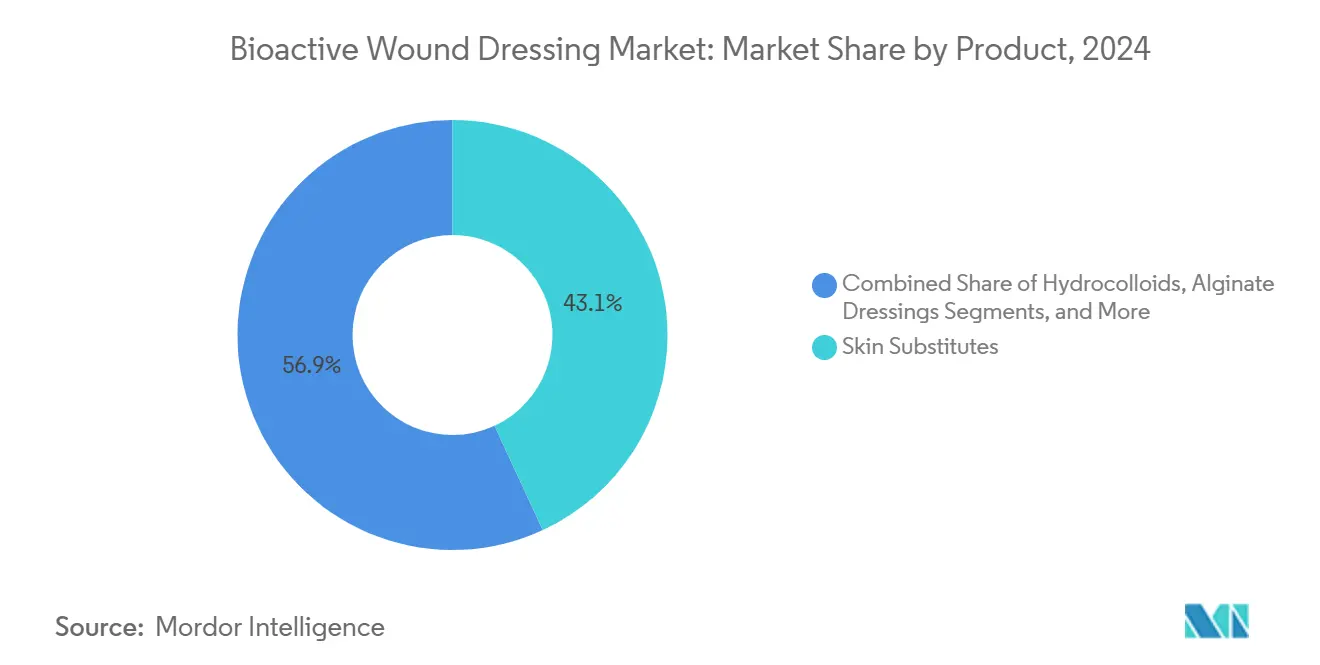
Note: Segment shares of all individual segments available upon report purchase
By Application: Diabetic Care Accelerates Growth
Surgical and traumatic wounds generated 46.48% of bioactive wound dressing market revenue in 2024, anchored by predictable procedure volumes and standardized care pathways. In contrast, diabetic foot ulcers post the highest trajectory at 11.36% CAGR, reflecting rising diabetes prevalence and evidence that fish-skin grafts yield 92% closure within 16 days compared with 75% under conventional care. The bioactive wound dressing market size for diabetic foot ulcer care surpassed USD 0.8 billion in 2024 and is climbing rapidly toward parity with surgical indications.
Burns, though lower in incidence, justify premium-priced biologic matrices that reduce scarring and pain. Pressure, venous, and arterial ulcers rely heavily on moisture-balance hydrogels and antimicrobial alginates; platelet-rich plasma and stem-cell impregnated fabrics hold promise for chronic complex sites but require robust cold-chain logistics, limiting uptake in resource-constrained geographies.
By End User: Outpatient Shift Transforms Delivery
Hospitals and inpatient centers commanded 79.39% of global revenue in 2024 as complex wounds necessitated clinician oversight, yet outpatient clinics and ambulatory surgery centers are expanding at 11.62% CAGR. The bioactive wound dressing market size in outpatient settings was USD 0.8 billion in 2024 and is forecast to double by 2030 as payers push lower-cost sites of care.
Telemedicine-enabled home health programs now pair sensor dressings with cloud dashboards, letting nurses monitor healing remotely and reducing travel burden for frail patients. Specialized wound centers act as hybrids, offering high-acuity care without full hospital costs; standardized AI-driven assessment tools ensure consistent treatment quality across sites.
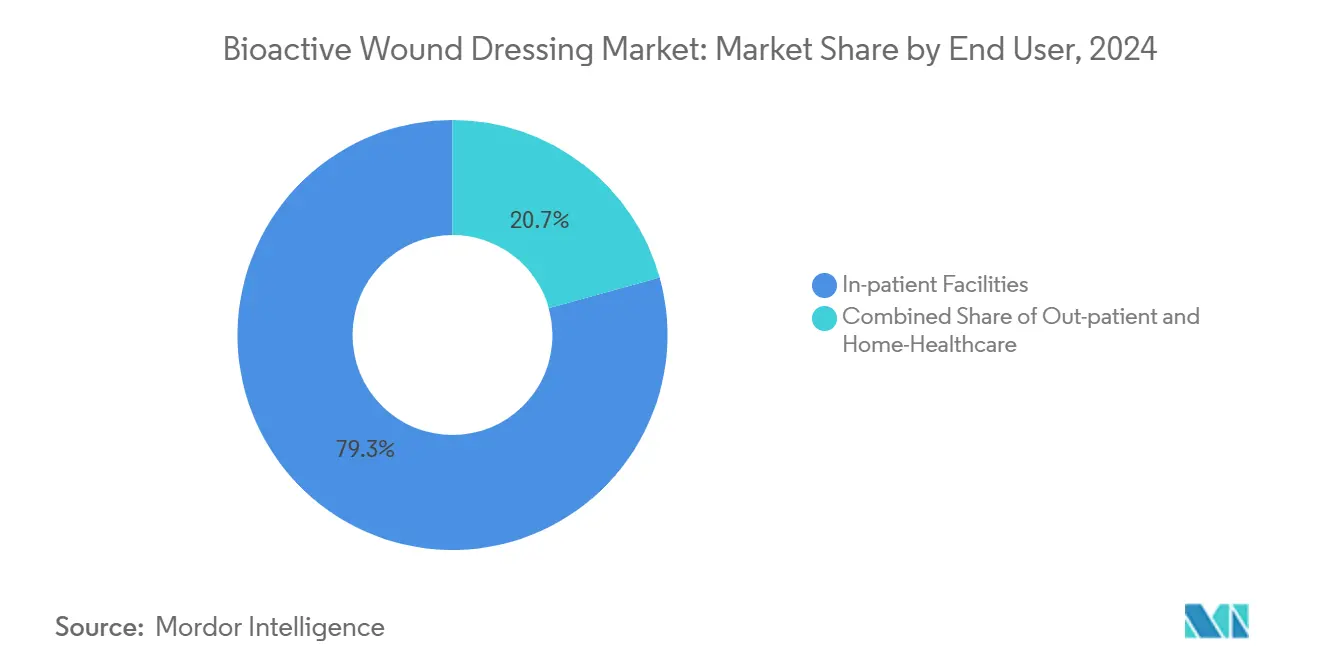
Note: Segment shares of all individual segments available upon report purchase
Geography Analysis
North America led with 42.67% of bioactive wound dressing market share in 2024, buoyed by Medicare coverage expansion and robust clinical-evidence demands that reward differentiated technologies. Regional innovations such as Solventum’s V.A.C. Peel and Place Dressing have cut application time by 61% and overall costs by 41%, cementing provider confidence [2]Solventum, “V.A.C. Peel and Place Dressing Performance Data,” solventum.com. Despite a 2.93% Medicare payment reduction in 2025, the region’s aging populace and high diabetes incidence sustain long-run demand; Department of Defense contracts worth USD 75 million underscore continued government backing for trauma solutions.
Asia-Pacific is the fastest-growing territory at 11.84% CAGR through 2030, propelled by rising incomes, insurance coverage, and modernizing regulatory frameworks. India’s updated marketing code for medical devices signals tighter compliance and smoother entry for foreign brands, while local manufacturing capacity drives competitive pricing. Clinical studies reveal biodegradable temporizing matrices achieve 94.6% healing rates across Asian cohorts, reinforcing clinician trust [3]Journal of Functional Biomaterials, “Biodegradable Temporizing Matrix in Asian Patients,” mdpi.com.
Europe records steady progress, supported by rigorous health-technology assessments that reward proven efficacy. HARTMANN reported EUR 608.9 million wound-care revenue in 2024, up 4.4% organically, reflecting demand for silicone super-absorbents that manage complex exudate scenarios. Sustainability priorities boost alginate and chitosan uptake, while post-Brexit regulatory alignment remains a moving target but is unlikely to derail continental adoption. Emerging markets in Latin America and Africa present long-term upside yet demand lower-cost variants and infrastructure-friendly supply chains.
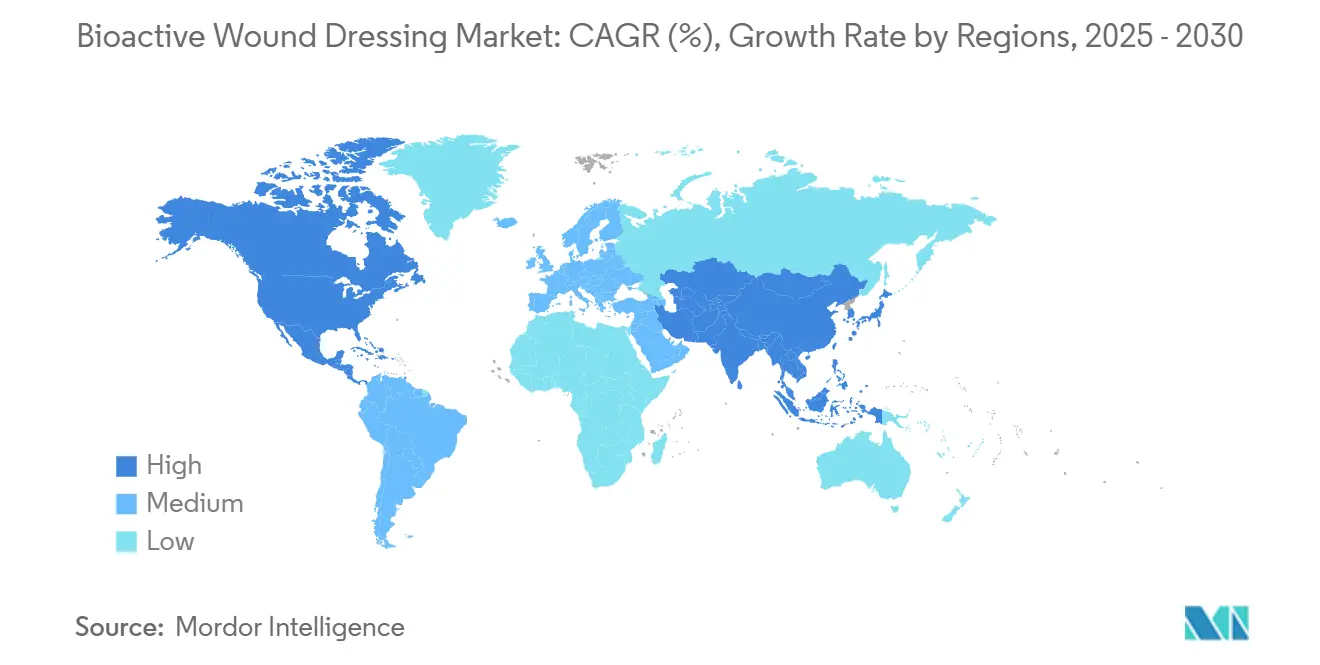
Competitive Landscape
The bioactive wound dressing market remains moderately concentrated. Smith+Nephew, ConvaTec, and Mölnlycke collectively capture more than 40% of global revenue, leveraging legacy brands, multi-country sales teams, and extensive clinical data libraries. Smith+Nephew’s focused investment in negative-pressure therapy and large-surface biologic matrices positions it to retain hospital contracts, while ConvaTec emphasizes ostomy and wound synergy to cross-sell dressings.
Disruptors press incumbents on two fronts: biologic innovation and digital enablement. Kerecis built a fish-skin graft franchise that earned rapid U.S. and Nordic defense uptake thanks to natural omega-3 profiles linked to anti-inflammatory effects. Vomaris targets infection control with bioelectric micro-current dressings that deactivate pathogens without antibiotics, a strategic advantage as antimicrobial-resistance concerns mount.
Regulatory shifts reshape the field. The FDA proposes to reclassify antimicrobial coatings based on resistance risk, pushing higher-risk categories into premarket approval and favoring well-capitalized firms with deep regulatory capacity. Traditional device firms lacking sensor expertise increasingly partner with digital-health startups to embed analytics, creating blended offerings that deliver both physical healing and data-driven insights.
Bioactive Wound Dressing Industry Leaders
-
3M
-
B. Braun SE
-
Convatec Group PLC
-
Monlnlycke Health Care AB
-
Smith & Nephew PLC
- *Disclaimer: Major Players sorted in no particular order
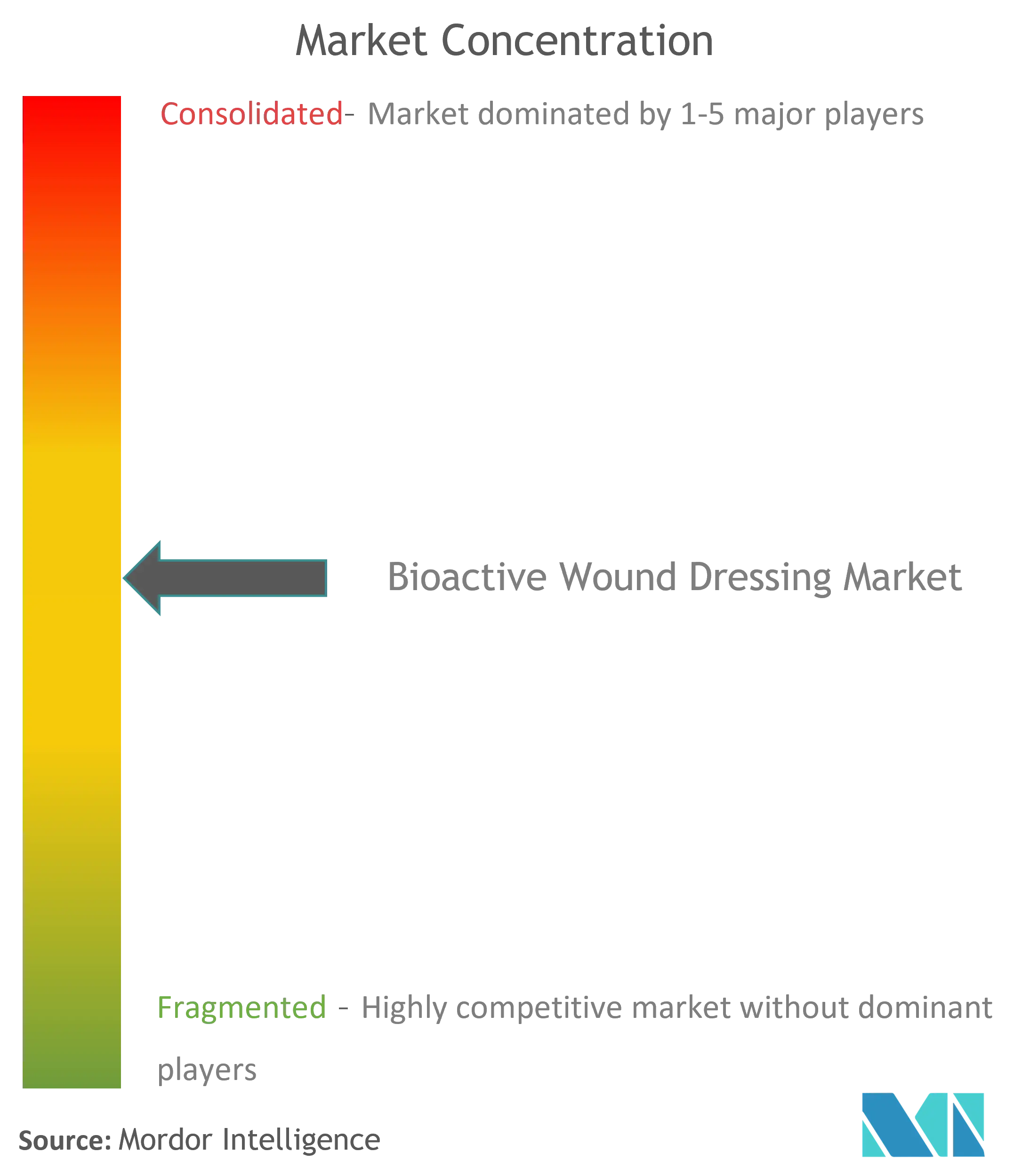
Recent Industry Developments
- January 2025: FDA granted Fast Track Designation to SolasCure’s Aurase Wound Gel for calciphylaxis ulcers, creating a pathway for accelerated market entry of enzyme-based hydrogels.
- October 2022: Queen’s University Belfast researchers released Scaffold, an affordable bandage engineered for diabetic foot ulcers.
- June 2022: Medline introduced an updated Optifoam Gentle EX Foam dressing, broadening its Skin Health Solution Program.
Research Methodology Framework and Report Scope
Market Definitions and Key Coverage
Our study defines the bioactive wound dressing market as all sterile dressings that either contain bio-derived materials or are impregnated with biologically active molecules able to interact with the wound bed and accelerate tissue repair, including collagen, alginate, chitosan, cellulose, skin substitutes, and emerging smart bio-electronic matrices. According to Mordor Intelligence, dressings that merely provide passive moisture balance or negative pressure, as well as hemostatic agents, are not counted.
Scope exclusion: products such as traditional gauze, NPWT devices, sutures, sealants, and topical pharmaceuticals are left outside this market.
Segmentation Overview
- By Product
- Hydrocolloids
- Alginate Dressings
- Collagen-based Dressings
- Skin Substitutes (Acellular & Living)
- Antimicrobial/Silver Dressings
- Chitosan & Bacterial-Cellulose Dressings
- Growth-Factor / Stem-Cell Impregnated
- Smart Bio-electronic Dressings
- By Application
- Surgical & Traumatic Wounds
- Burns
- Diabetic Foot Ulcers
- Pressure Ulcers
- Venous & Arterial Ulcers
- Donor-Site & Other Chronic Wounds
- By End User
- In-patient Facilities
- Out-patient / Ambulatory Settings
- Home-Healthcare
- By Geography
- North America
- United States
- Canada
- Mexico
- Europe
- Germany
- United Kingdom
- France
- Italy
- Spain
- Rest of Europe
- Asia-Pacific
- China
- Japan
- India
- Australia
- South Korea
- Rest of Asia-Pacific
- Middle East & Africa
- GCC
- South Africa
- Rest of Middle East & Africa
- South America
- Brazil
- Argentina
- Rest of South America
- North America
Detailed Research Methodology and Data Validation
Primary Research
Mordor analysts interviewed wound-care nurses, purchasing heads at hospitals, product managers at dressing manufacturers, and regional distributors across North America, Europe, and Asia-Pacific. These conversations validated incidence assumptions, average selling prices, and adoption curves for next-generation silver, collagen, and sensor-enabled dressings, filling data gaps that secondary sources left open.
Desk Research
We began by mapping supply and demand using open datasets from sources such as the WHO Global Health Observatory, CDC National Diabetes Statistics, UN DESA population projections, and United States CMS Medicare claims, which together outline the growing chronic wound pool. Trade flows from UN Comtrade and customs portals helped gauge alginate and collagen import volumes, while device approvals retrieved from the US FDA 510(k) database signaled pipeline momentum. Company filings accessed through D&B Hoovers, news archives in Dow Jones Factiva, and peer-reviewed clinical journals supplied price trends and efficacy benchmarks. This list is illustrative; many other public and subscription sources were tapped for cross-checks and clarity.
Market-Sizing & Forecasting
A top-down incidence-to-treatment model converts diabetic foot, pressure, venous, surgical, and burn wound cases into addressable dressing demand, which is then stress tested with selective bottom-up supplier revenue roll-ups and channel checks. Key model drivers include treated wound prevalence, procedure volumes, average dressing change frequency, weighted ASP movement, reimbursement penetration, and biomaterial innovation rates. Forecasts to 2030 are generated through multivariate regression combined with scenario analysis around diabetes growth and material cost swings; expert panels review the variable trajectories before sign-off. Data gaps in bottom-up inputs are bridged by regional ASP proxies and capacity utilization cues.
Data Validation & Update Cycle
Outputs pass variance tests versus external market signals, and anomalies trigger a two-step analyst review before release. Reports refresh annually, with interim revisions whenever regulatory shifts, large recalls, or M&A events materially alter the baseline, ensuring clients always receive the latest vetted view.
Why Mordor's Bioactive Wound Dressing Baseline Stands Dependable
Published figures often diverge because each firm selects different product mixes, base years, and currency treatments. Our disciplined scoping, regular refresh cadence, and dual-path (top-down with bottom-up corroboration) modeling reduce such drift.
Key gap drivers include: some publishers fold advanced but passive foams into 'bioactive,' others apply aggressive multi-layer ASP mark-ups, and a few rely on five-year-old incidence data. Mordor reports only dressings with intrinsic biological activity, prices them at observed tender levels, and updates epidemiology annually.
Benchmark comparison
| Market Size | Anonymized source | Primary gap driver |
|---|---|---|
| USD 3.87 B (2025) | Mordor Intelligence | - |
| USD 3.5 B (2024) | Global Consultancy A | Counts passive moist foams as bioactive; older base year |
| USD 12.0 B (2024) | Research Publisher B | Bundles overall advanced dressings and NPWT devices |
| USD 4.66 B (2024) | Independent Analytics C | Uses list prices instead of tender ASPs |
In sum, because our scope is precise, variables transparent, and checks iterative, Mordor Intelligence delivers a balanced, reproducible baseline that decision-makers can trust when sizing opportunities or benchmarking growth.
Key Questions Answered in the Report
What is the current Bioactive Wound Dressing Market size?
The bioactive wound dressing market size is USD 3.87 billion in 2025 and is projected to reach USD 6.40 billion by 2030 at a 10.53% CAGR.
Who are the key players in Bioactive Wound Dressing Market?
3M, B. Braun SE, Convatec Group PLC, Monlnlycke Health Care AB and Smith & Nephew PLC are the major companies operating in the Bioactive Wound Dressing Market.
Which is the fastest growing region in Bioactive Wound Dressing Market?
Asia-Pacific is advancing at 11.84% CAGR, spurred by regulatory modernization, rising incomes, and expanding healthcare infrastructure.
Why are diabetic foot ulcers a strategic focus?
Diabetic foot ulcers are expanding at 11.36% CAGR because diabetes affects 537 million adults globally, and bioactive solutions significantly improve closure rates.
Page last updated on:



